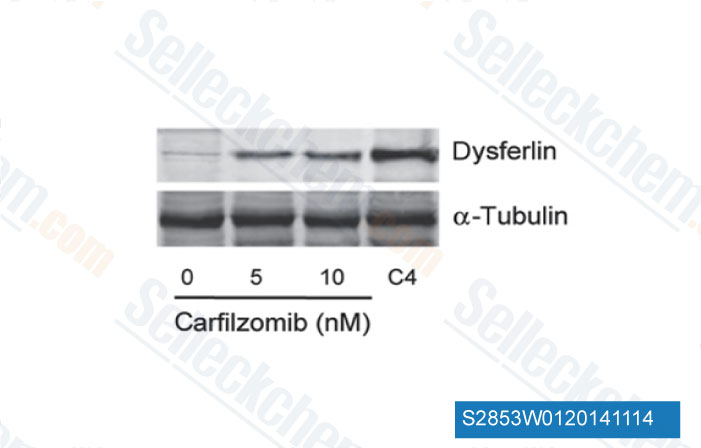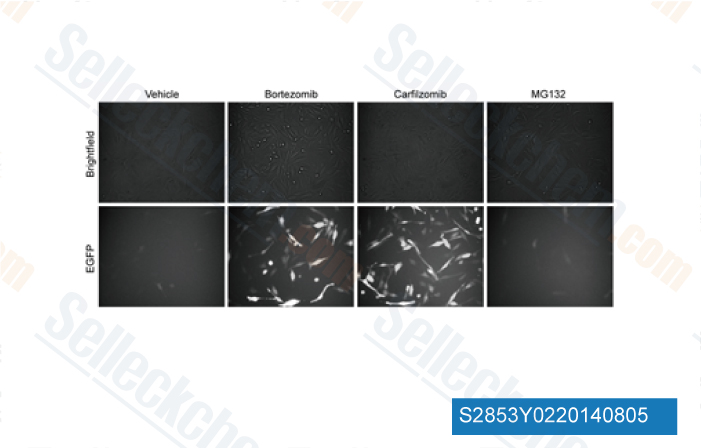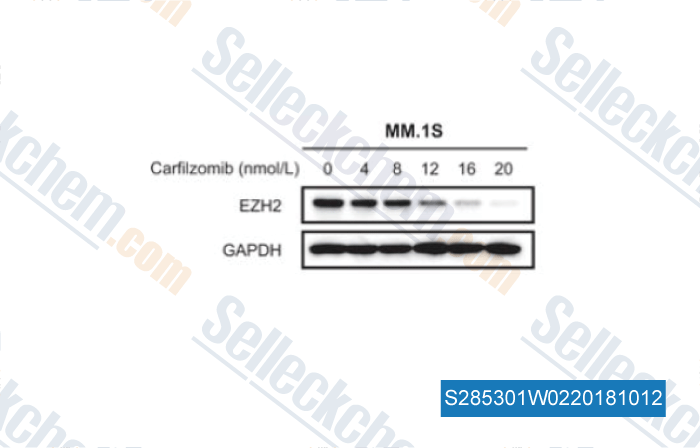|
Toll Free: (877) 796-6397 -- USA and Canada only -- |
Fax: +1-832-582-8590 Orders: +1-832-582-8158 |
Tech Support: +1-832-582-8158 Ext:3 Please provide your Order Number in the email. |
Technical Data
| Formula | C40H57N5O7 |
||||||
| Molecular Weight | 719.91 | CAS No. | 868540-17-4 | ||||
| Solubility (25°C)* | In vitro | DMSO | 100 mg/mL (138.9 mM) | ||||
| Ethanol | 50 mg/mL (69.45 mM) | ||||||
| Water | Insoluble | ||||||
| In vivo (Add solvents to the product individually and in order) |
|
||||||
|
* <1 mg/ml means slightly soluble or insoluble. * Please note that Selleck tests the solubility of all compounds in-house, and the actual solubility may differ slightly from published values. This is normal and is due to slight batch-to-batch variations. * Room temperature shipping (Stability testing shows this product can be shipped without any cooling measures.) |
|||||||
Preparing Stock Solutions
Biological Activity
| Description | Carfilzomib (PR-171) is an irreversible proteasome inhibitor with IC50 of <5 nM in ANBL-6 cells, displayed preferential in vitro inhibitory potency against the ChT-L activity in the β5 subunit, but little or no effect on the PGPH and T-L activities. Carfilzomib activates prosurvival autophagy and induces cell apoptosis. | ||
|---|---|---|---|
| Targets |
|
||
| In vitro | Carfilzomib inhibits proliferation in a variety of cell lines and patient-derived neoplastic cells, including multiple myeloma, and induced intrinsic and extrinsic apoptotic signaling pathways and activation of c-Jun-N-terminal kinase (JNK). Carfilzomib reveals enhanced anti-MM activity, overcome resistance to other agents, and acts synergistically with (Dex). Carfilzomib shoes preferential in vitro inhibitory potency against the ChT-L activity in the β5 subunit, with over 80% inhibition at doses of 10 nM. Short exposure to low-dose Carfilzomib leads to preferential binding specificity for the β5 constitutive 20S proteasome and the β5i immunoproteasome subunits. Measurement of caspase activity in ANBL-6 cells pulsed with Carfilzomib reveals substantial increases in caspase-8, caspase-9, and caspase-3 activity after 8 hours, giving a 3.2-, 3.9- and 6.9-fold increase, respectively, over control cells after 8 hours. In carfilzomib pulse-treated cells, the mitochondrial membrane integrity is decreased to 41% (Q1 + Q2), compared with 75% in vehicle-treated control cells. [1] In another study, Carfilzomib has also shown preclinical effectiveness against hematological and solid malignancies. [2] Carfilzomib directly inhibits osteoclasts formation and bone resorption. [3] |
||
| In vivo | Carfilzomib moderately reduces tumor growth in an in vivo xenograft model. Carfilzomib effectively decreases multiple myeloma cell viability following continual or transient treatment mimicking. Carfilzomib increases trabecular bone volume, decreases bone resorption and enhances bone formation in non-tumor bearing mice. [3] |
Protocol (from reference)
| Kinase Assay: |
|
|---|---|
| Cell Assay: |
|
| Animal Study: |
|
References
Customer Product Validation

-
Data from [Data independently produced by Sci Transl Med, 2014, 6(250), 250ra112]

-
Data from [Cancer Res, 2014, 74(16), 4458-69]

-
Data from [J Virol, 2013, 87(23), 13035-41]

-
Data from [Data independently produced by , , Clin Cancer Res, 2017, 23(16):4817-4830]
Selleck's Carfilzomib (PR-171) has been cited by 255 publications
| Interferon-α promotes HLA-B-restricted presentation of conventional and alternative antigens in human pancreatic β-cells [ Nat Commun, 2025, 16(1):765] | PubMed: 39824805 |
| Diving on the Surface of a Functional Metal Oxide through a Multiscale Exploration of Drug-Nanocrystal Interactions [ ACS Appl Mater Interfaces, 2025, 17(7):10432-10445] | PubMed: 39930563 |
| Oversized cells activate global proteasome-mediated protein degradation to maintain cell size homeostasis [ Elife, 2025, 14e75393] | PubMed: 39791360 |
| Role of the NuRD complex and altered proteostasis in cancer cell quiescence [ bioRxiv, 2025, 2025.02.10.637435] | PubMed: 39990343 |
| Stress response silencing by an E3 ligase mutated in neurodegeneration [ Nature, 2024, 626(8000):874-880] | PubMed: 38297121 |
| Synergistic induction of mitotic pyroptosis and tumor remission by inhibiting proteasome and WEE family kinases [ Signal Transduct Target Ther, 2024, 9(1):181.] | PubMed: 38992067 |
| Proteasome inhibition enhances the anti-leukemic efficacy of chimeric antigen receptor (CAR) expressing NK cells against acute myeloid leukemia [ J Hematol Oncol, 2024, 17(1):85] | PubMed: 39285441 |
| Simultaneous proteome localization and turnover analysis reveals spatiotemporal features of protein homeostasis disruptions [ Nat Commun, 2024, 15(1):2207] | PubMed: 38467653 |
| The molecular dissection of TRIM25's RNA-binding mechanism provides key insights into its antiviral activity [ Nat Commun, 2024, 15(1):8485] | PubMed: 39353916 |
| FNDC4 alleviates cardiac ischemia/reperfusion injury through facilitating HIF1α-dependent cardiomyocyte survival and angiogenesis in male mice [ Nat Commun, 2024, 15(1):9667] | PubMed: 39516487 |
RETURN POLICY
Selleck Chemical’s Unconditional Return Policy ensures a smooth online shopping experience for our customers. If you are in any way unsatisfied with your purchase, you may return any item(s) within 7 days of receiving it. In the event of product quality issues, either protocol related or product related problems, you may return any item(s) within 365 days from the original purchase date. Please follow the instructions below when returning products.
SHIPPING AND STORAGE
Selleck products are transported at room temperature. If you receive the product at room temperature, please rest assured, the Selleck Quality Inspection Department has conducted experiments to verify that the normal temperature placement of one month will not affect the biological activity of powder products. After collecting, please store the product according to the requirements described in the datasheet. Most Selleck products are stable under the recommended conditions.
NOT FOR HUMAN, VETERINARY DIAGNOSTIC OR THERAPEUTIC USE.
